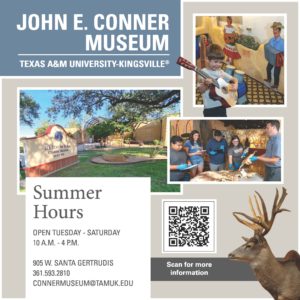Every day mothers walk the halls of Texas A&M University-Kingsville. But one mother has claimed her place in the courtyard of Eckhardt Hall. Her home is made of mud, twigs, leaves, saliva and feathers.
She is a black vulture nicknamed, “Buzz the Buzzard,” by the staff and faculty in Eckhardt Hall.
Rocky Vela and Jose Reyes, facilitators, noticed “Buzz” at the beginning of March hanging around the courtyard swooping down every once in awhile to pick up fallen twigs and bugs.
They assumed she was gathering material to make a nest somewhere, but she was canvassing the area to pick the perfect spot to nest.
A few days later, Vela realized that as “Buzz” flew away from the nest, two eggs rested in her newly crafted home.
But suddenly another bird lighter in color appeared and guarded the nest, the father. Vela and Reyes explained that both birds take turns caring for the youngsters and scavenge for food.
Most birds choose locations far away from people and outside forces, but she chose her location and hasn’t moved since.
“It’s really rare for birds to stay there like that. It’s really cool,” Vela said.
Arnoldo Perez, associate director of the EOC Rural program for the Office of Student Access, also noticed her lurking outside as he made his way in and out of his office every day.
Perez called the TAMUK Wildlife Society and they advised him not to touch or move the nest as this particular bird is aggressive and will attack or vomit on perpetrators. Vela then researched and learned that the gestation period for the eggs is 38 to 39 days. So the wait began.
Perez, Vela and Reyes would check up on her every day making sure she was okay, and hadn’t fled or been hurt.
Some people would assume “Buzz” would be a nuisance and distract workers from their duties, but because she is off to one corner of the courtyard she is out of the way, and does not instigate problems.
One day, a maintenance worker drove up into the courtyard to pick up garbage, and as he approached the nest, “Buzz” stood up, spread her wings in a defensive stance and walked towards the worker.
The worker quickly backed away, got back on the gator, and drove away without a problem.
“It’s interesting and also scary to have a buzzard around. This bird is capable of killing a wide variety of prey when hungry. One must be cautious while being around this building,” Tanishka Guduru, an information systems major and student worker at Eckhardt Hall said.
During the first week of April, the young birds finally hatched. The little birds are not as dark and mysterious in appearance as their mother or father, their wings are a much lighter brown than their parents.
Almost every day the birds walk a few feet away from the nest as they learn how to survive in the new world, but neither baby bird has been spotted flying yet.
Faculty and staff members in Eckhardt Hall hope “Buzz” will help her babies fly freely, and move on to the next destination as their journey continues.
Currently, “Buzz” and her family still remain in the courtyard of Eckhardt Hall.
“I had never put much thought into the life of a buzzard until now. They are interesting creatures. I’m good with it nesting here,” Perez said. And even though “Buzz” has become a symbol of nature at its finest, and a personal mascot for Eckhardt Hall, faculty and staff understand that when it’s time to let “Buzz” and her babies fly off, they will graciously let them go.
